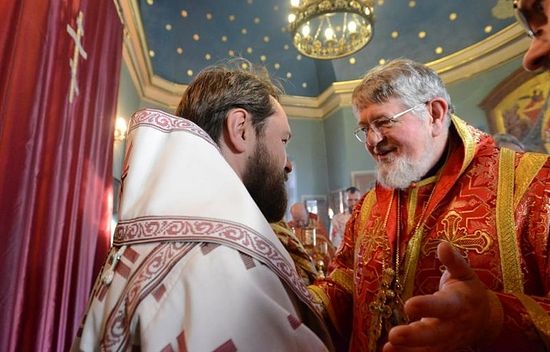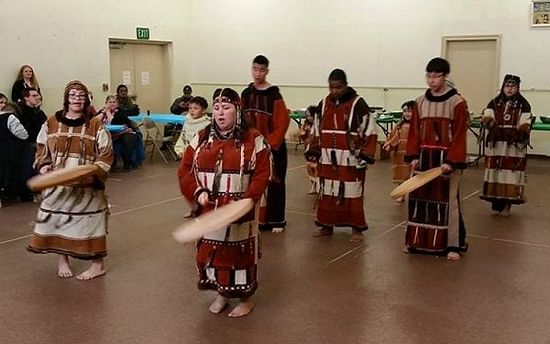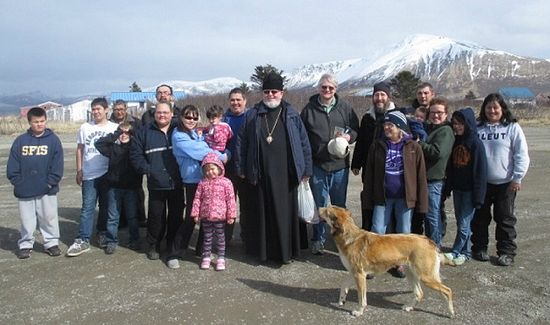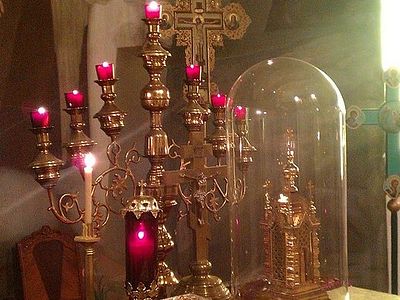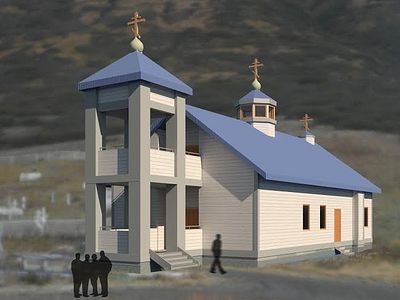From December 5-10, 2015 His Grace Bishop David (Mahaffey) of Sitka and Alaska (OCA) made a pilgrimage to the holy sites in and around Moscow, and especially to serve at St. Catherine’s, the OCA representation parish in Moscow, on it’s patronal feast day. His Grace, consecrated in February 2014, took some time out of his busy schedule to speak with us about his time in Moscow and to share some reflections on his experience and continuing work in Alaska.
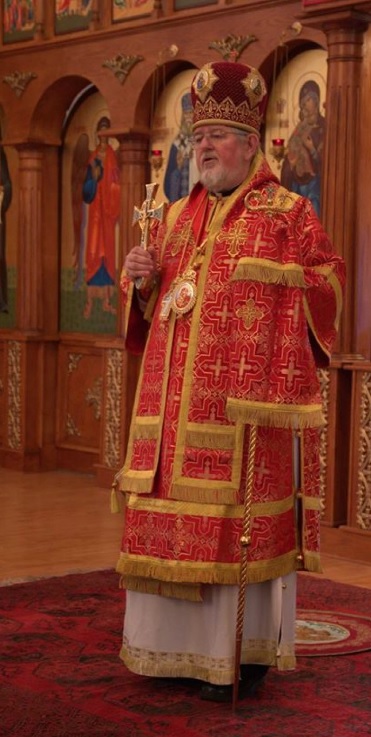
—Your Grace, thank you for giving some time to share some thoughts with our readers. To begin with, what brings you to Russia?
—Every year the Synod sends a bishop for the feast of St. Catherine because it’s our podvoriye[1] and this year I actually asked to go. I’ve never been to Russia before.
—What’s your impression so far?
—It’s a lot to take in. You can’t do it justice in a week, really. They took me to the Trinity-St. Sergius Lavra yesterday and I got to venerate the relics of St. Innocent, and of course St. Sergius and they opened the glass to let me venerate him. We got there just as they were finishing the Akathist, so we all knelt while the priest read the prayer, which was amazing. The day before they took me all around Moscow. We went to see St. Matrona.
—You have to go to St. Matrona.
—And St. Hilarion, and to St. Tikhon the Patriarch.
—St. Innocent and St. Tikhon in one trip—that’s pretty nice.
—Inside me is kind of a fear that I didn’t do them enough proper veneration while I was here, that I feel short-handed somehow, because I wasn’t expecting it. And then when you just see how many churches there are—it’s a whole different world compared to American Orthodoxy.
Other than visiting the relics of all these saints, the other highlight was that today the bell-ringer at Christ the Savior Cathedral took me up into the bell tower and rang the bells for me, and that was amazing. And he knows all about the bells and the church so it was very interesting. I’m sure you’ve been there.
—Well, yes, I’ve been to the church.
—Have you ever been to the church downstairs?
— I like it a lot better.
—It’s only the second place I’ve heard of, and the first I’ve seen with my own eyes, that has the iconography of the book of Revelation on the walls. The only other time I’ve heard of it was from the late Archbishop Job. I knew him since he was a priest because he was in a parish near me when I was a deacon, so we served together. He came back from Mt. Athos one time and he had photographs from a church there, so I knew that what I was looking at here was Revelation. And Abp. Job was an iconographer, so he explained to me that you don’t often see this. We don’t use Revelation liturgically, and he said this is our representation of Revelation. It’s never in the church but it can be in the vestibule.
—I’ll have to go again and take a look.
—It’s an amazing thing, because you see the seven-headed beast and all that. Some churches have the Last Judgment on the back wall as you leave. That was the first thing I saw and then I went to the right and I saw the whore of Babylon and the prophet and the whole thing and I was just so impressed.
—Were you able to make it to the Valaam Podvoriye?
—Yes, with Fr. Joseph. He went to St. Tikhon’s[2]. He graduated after me but I remember him from St. Tikhon’s. He was very quiet, very humble, and very pious.
—And of course St. Herman is from Valaam and they have some beautiful icons of him there, so I thought it would be nice for you to go.
—Fr. Daniel and I are thinking about putting together a tour for next summer. We’ll see if we can.
—How has it been serving at St. Catherine’s?
—We arrived at about 3 o’clock on Saturday and came straight here for Vigil. I served Liturgy on Sunday morning and then I served Vigil that night. Were you here for that?
—I was here just on Monday for the Liturgy for St. Catherine.
—We had the full vigil on Sunday night for St. Catherine, with the Akathist, and then Metropolitan Hilarion [Alfeyev] came on Monday and of course he serves first.
—I didn’t know he was going to be there. I had just seen online the day before that you were going to be here. I assumed you would be first and there would be more English.
—I know. Sunday we had quite a bit of English. But as I understand this was the only parish where he was a priest, so he has nostalgia for this place.
—I had no idea that he served as a priest here.
—And his actual church is only about a block away from here or so.
—That’s right. That was the first time I’ve ever seen him serve.
—I’m sure he didn’t remember but he and I were both in Batak in 2011 for the feast of the New Martyrs of Batak. I represented the OCA as a priest then, and he came representing Moscow.
—Batak is where?
—Batak is in Bulgaria. Thousands of them were martyred by the Turks in 1876. They basically massacred the whole town, and behind the altar in the main church they had this huge vault that they made in the ground with the bones of all the martyrs, and when they canonized them they made a reliquary that’s as big as a casket that has a glass top and you can see all the skulls in there of all the people who were martyred.
—How were you chosen to represent the OCA?
—I had been to Bulgarian before in 2008 as a guest of a parishioner of mine who wanted me to come and baptize his baby. His family happened to know the Metropolitan very well, Nikolai of Plovdiv, and when he found out I was there then I had to be part of his entourage that weekend. When 2011 came up I said to the Synod that if no one else wanted to go then I would go because I knew the area and the bishop, so they blessed me to go.
—Your Grace, what can you tell us about life as the bishop of Alaska?
One thing I found out as a hierarch—our schedules get so busy. Since I moved to Alaska in 2013 I don’t think I’ve had three weekends in a row in Anchorage. You can’t drive almost anywhere. All the parishes are village parishes on rivers or on the Aleutian chain or in the south-east which is also islands. And of course for them to have the bishop come is usually a major thing so it has to be on a weekend, and obviously they look forward to it, so you try to put together a lot of things in one weekend. I usually fly out Friday morning or afternoon and I don’t return until Monday, because a lot of the planes don’t fly out from the villages on Sundays. And if the weather’s not good they won’t pick you up on Monday. I’ve been stranded, and sometimes I’ve been unable to get somewhere, like to St. Paul Island. And actually the airline that flies to St. Paul Island is run by an Orthodox family and they give me ten free flights a year.
—That’s pretty nice!
—Yes it is. My furthest western parish is Atka now, which is about halfway out the Aleutian chain. We used to have a parish on Attu but that’s the one where the Japanese came and imprisoned them. When the Japanese came to Alaska, which is the only American soil they set foot on, they rounded up the people of Attu and took them as prisoners back to Japan and when they were released after the war the navy brought them as far as Atka and wouldn’t go out to Attu, so now they live amongst the Atkans. And even among the Aleuts the Atka dialect is not the same as the Unagan dialect of Unalaska, which is not the same as the St. Paul dialect. There’s little differences—they know I don’t know, but they say that even people from Attu weren’t speaking the same language as them.
As a point of reference St. Innocent studied Unalaskan Unagan Aleut and that’s what he used to translate the Gospel and catechism. But St. Iakov, who was an Atkan, translated for the Atkan dialect.
—It’s different enough that they needed their own translations?
—It’s a different book.
—That’s quite an undertaking.
—Indeed. So we cannot appreciate enough what the Russians did for the people of Alaska, in any way, shape or form. I don’t know if you know about the whole American experience, but after Alaska was sold they turned it over to this guy named Sheldon Jackson, who happened to be a Presbyterian minister, to be the administrator of Alaska for America, and they told him that he needed to establish schools to teach English to the children, so he went around to different Protestant denominations and said they could send missionaries as long as they were school teachers. They divided the state up and the Baptists got a part, the Methodists got a part, the Moravians even got a part, the Episcopalians got a part, the Presbyterians got a part, and the Catholics got a part, but the state was mainly divided up between different Protestants. And the natives, much like the Irish under English rule, were not allowed to use their native language or wear their native dress. They didn’t even understand school in that way in their experience with the Russians. The children would even be punished if they spoke their native language. So they tried very hard to destroy a lot of the native culture.
The Russians, on the other hand, did the opposite. They translated and taught and blessed anything they could bring in and make Christian. The spirit houses you hear about are an example of this. The Athabascans had a belief that after death the soul leaves but it comes back and visits the body so they built a house for the spirit to live in. The Church saw that they understood that man is body and soul, so that was a teaching tool for them. Their story of creation has a flood in it; the concept, which Orthodoxy has always had, of the reverence for nature, because God has created it and so we have to appreciate it and its just not ours to take and do what we want with; the native concept of the animals actually giving themselves to us for food tied into the understanding that everything is a blessing from God, and the Russians understood all that. And then the Americans came along …
I don’t know if you ever saw Fr. Michael Oleska’s book on Alaskan missionary work. They eventually ended up taking the kids out of their villages and putting them in boarding schools, and in the back of that book there’s a letter from the priest to the Methodist boarding school at Christmas time to say their children needed to have the services and Communion and he wanted to come, and the letter back said, “You don’t need to come—they’ll do Christmas with us.” They denied him even to minister to his own people.
—How much did it wipe out their memory and attachment to Orthodoxy?
—There are Protestant villages which were entirely anglicized, and there’s Orthodox villages almost side-by-side.
Here’s one story. Because of the way the river flows sometimes the Yupiks have to move their entire village, and they asked some Moravians who had already built another village if they could come and stay there, and they said, “No, you’re not Moravians. You can’t come here.” So they found another place and built a new village. Guess what happened? The river changed and the Moravians had to move, and they came to the Orthodox and said, “Can we live here?” and they said, “Of course,” and let them move in. So there’s the difference.
Between the Tlingit and Athabascan and Aleut and Yupik, with all the different dialects, on any given Sunday in Alaska God is praised in twelve different languages, because they use Slavonic and they use English, and then all their dialects.
—Have you learned little bits from each dialect? I heard you say something in the Liturgy.
—Yes, “Peace be unto all,” and I know “Christ is Risen” and some other phrases. They have some different sounds in their dialects that you have to listen for. I’m not fluent in anything. I know a word here and there so I know when they’re saying something to me, like “thank you.”
—It shows them that you’re trying. I’m sure they appreciate that.
—Right. I just try to love them.
One of the two things I’d like to accomplish as bishop of Alaska is to increase the appreciation for monasticism, because that’s not even in their DNA, actually. Because they had such a high mortality rate, preservation is about having lots of children. So I need a wife because I have to have children. It’s nothing for them to have four, five, six, seven kids. Birth control isn’t even on their radar. It’s more important to have children.
I think monasticism can be developed but the concept hasn’t been there really.
—They’re used to a hard life, so that could be a foot in the door maybe.
—This is the other thing about Alaska—there’s a very strong sense of community. There’s no such thing as an individual in Alaska, because if you are you’re just dead. If you think you’re going to go out in Mother Nature and win, good luck. You learn to work with Mother Nature. Like I said, in the lower forty-eight they wait for the snow plow to come, they turn up the thermostat when it’s cold. It means nothing to them, but in Alaska it doesn’t work like that. And when you have to pay ten or eleven dollars a gallon for stove oil to heat your house, because that’s’ all they can have, and you don’t have much of an income, it’s a lot. All this tends to make them appreciate what they do have even more. And they just have to live within those means.
—Speaking of monasticism, is there much of a relationship with the monasteries that are there, under the Serbians?
—I don’t know how much you know of their history, but let’s remember that they were under Platina and they were non-canonical, and so the OCA was bad—“There’s no grace in the OCA so we can’t go there”—so there wasn’t much effort made to contact them. When they decided that they needed to be canonical it was just kind of natural for them to go with Bp. Jovan, the Serbian bishop at the time who was a very monastic man himself. I can’t fault them, I just wish we had been able to reach them.
I wasn’t even going to go to Alaska when I first got the phone call, except that a friend of mine on the Synod said I should go take a look, and I can’t say how much it’s changed me and been good for me.
—Could you say a little bit about that?
—I can. When I lost my wife I didn’t want another wife. I wasn’t going to leave the Church or the priesthood. But I really struggled. I was dutiful. I did everything they asked me to do and I took care of my parishes, but inside I was really being torn apart, and I felt like I was just going through the motions. I sometimes wondered if I was even there, as a person. I felt that removed from what I was actually doing. And I just resigned myself that this was going to be my life. Of course I have children and I love them and I have three granddaughters.
They sent me to Napaskiak Alaska in January, and it was never above twenty-five degrees below zero the whole week, and at night it was thirty-five or forty below with the winds blowing at twenty miles per hour or more. But every night we were in church and every night that church was full. And the people didn’t come grumbling and complaining about the weather—they were smiling and singing and praying and they were so happy we were there. And I knew there was something going on that I haven’t experienced before and I wanted more of it, and so I went back the second time, and the third time when they asked me to go. And I just left it up to God and said, “If that’s where You want me to go, I don’t understand why, but I’ll do it.” I really felt a pull and I felt it’s what God wanted me to do but I really didn’t know why.
My wife’s repose was August 8.Well, if you’re the bishop of Alaska, on August 8th you’re on Spruce Island.
—Sure, it’s’ the eve of St. Herman.
—It’s the eve of St. Herman, and on the old calendar it’s also St. Iakov, by the way. Anyways, I went there and I didn’t know how I would feel about it. I decided go to the church early and pray a Panihkida for my wife in front of St. Herman’s relics. I went back in the altar, and I don’t know if it was St. Herman talking to me or who, but somebody said to me in myself, “I replaced the beauty of your wife with the beauty of Alaska, and I replaced that love that you and your wife had with the love of these people for you.” And then I understood, “Ok, I get it. That’s fine.” I went up in March and this was August. So that whole time I still didn’t understand why God was sending me there. I was just there out of loyalty to my faith and my God but not understanding. But I’ve never had a second thought since then.
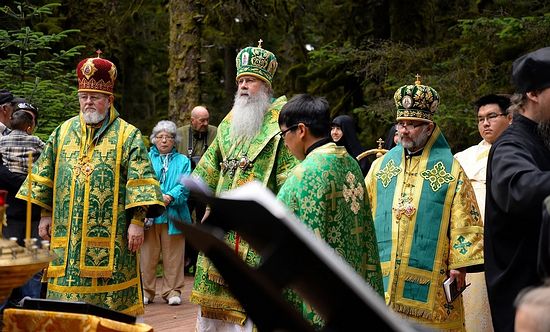 Bishop David serving with His Beatitude Metropolitan Tikhon and Bishop Daniel at Spruce Island in honor of St. Herman
Bishop David serving with His Beatitude Metropolitan Tikhon and Bishop Daniel at Spruce Island in honor of St. Herman
The joy of serving and going to those villages is nothing like anywhere else in the OCA. For instance, I’ve gone to villages where I had to use a honey pot, where they brought me a pan of hot water and said, “Here, this is what we have for you to wash up in.” Ok, fine, because I know they gave me the best they had. It wasn’t much by the standards of the lower forty-eight, but that was the best they had and they gave it to me. That touched me. That’s another reason that I like Alaska—they don’t have time for nonsense. Life is too important to them to have discussions about idiotic things, like where do you get your nails done, or what are you going to get in your hair this week?
—I can barely even imagine this village way of life.
— In some villages there isn’t really anything besides the church. The church is the center for everything. There might not even be a law enforcement agency but the priest and the chief are the law enforcement. They are on equal footing for them as far as respecting what they say and do. The priest might also be the person who’s at the school or the clinic in an administrative role, because he’s the priest. It’s what they do.
—He’s just the guy they go to.
—He’s the guy they go to.
—That’s a lot of responsibility, but it’s good that they respect the priest like that. That’s not like the lower forty-eight either, unfortunately.
—No, no. but they’re not without their problems. The advent especially in the modern era of TV and satellite reception has given them things that they never had before and they do have a generation coming up that sees the outside world and has a longing for it but doesn’t know how to get to it, and that can cause alcohol problems, and depression, and domestic abuse.
—So I would assume you are addressing these issues in some way. At St. Herman’s Seminary they learn alcohol training, right?
—We have RADACT: Rural Alaska Drug and Alcohol Counseling and Treatment. And we’re expanding that program and introducing some new sections to it. And that’s why I say, lots of times you’ll find the priest at the clinic helping with counseling. Earlier they could graduate and be licensed counselors but the state changed the requirements and they’re not in seminary long enough to do it anymore.
Fr. Michael Oleska makes the point that prior to Sheldon Jackson and the Protestant injection into Alaska, suicide was almost unheard of among the natives, but it’s grown ever since. And Protestants are supposed to be tea-totalers, right? And yet, the Moravian villages have just as much alcohol as the Orthodox villages do.
—So the priests play such a big role in the village, but do most villages have their own priest?
—No. For example, on the whole Aleutian peninsula we have about seventeen parishes but only one priest there now. We used to have two but I had to remove one priest because of alcohol but I have nobody to replace him with, and that’s the whole problem. When I discipline a priest like that, I’m just hurting the village, because not only do they no longer have a priest that drinks, but they don’t have anybody. I don’t know which is worse.
—And there’s been these unfortunate cases of vandalism lately—at the cathedral, and the one cemetery has been hit many times.
—The Sitka cemetery vandalism is different. It was actually three or four teenage kids.
—So they didn’t have ill will? It was just kids being kids?
—Kids being kids, but you know how people are about cemeteries. Actually if you would go there to the Orthodox cemetery you’d have a hard time finding it. They bury people in the woods, so you kind of just disappear into the woods. They know where the crosses are.
Interestingly enough, we’re still looking for the body of St. Iakov. We know the area that he’s in, but not the exact spot. The tradition is to make a wooden cross but when his wife died he actually put a stone up for her. Her grave is marked with this stone in Russian and in English, but we only know about where he is. We’re just starting the research on it, but I hope we can recover his relics.
And then we have Matushka Olga.
—Is there much local veneration for her?
—Oh my—high veneration. They already have her icon in almost every church. I actually had to stop my priests because they were starting to include her in the commemorations at the end of the Liturgy, and I told them they can’t do that. I said that I don’t mind the icons, but she’s not Saint Olga yet. The icons went up before me so I’m not going to tell them they have to take them down.
 Faithful gathered around Matushka Olga's grave on the occasion of the 35th anniversaroy of her repose
Faithful gathered around Matushka Olga's grave on the occasion of the 35th anniversaroy of her repose
—Is there talk of canonizing her? I think St. Peter the Aleut was just locally canonized in Alaska and then it just spread.
—He was. I’m now on the commission for canonization, so I’m researching her right now. Remember that she still has four or five children still alive. At the last diocesan assembly I put the word out that I need to know everything about her I possibly can—good and bad, because we don’t want to do something and then realize later it was a mistake. We want to know it all so we can sift through it. But she’s already appeared to people. A woman in New Jersey heard Fr. Michael Oleska talk about her, and she had a problem and prayed to her and she was healed, and she attributes it to Matushka Olga. And there’s a picture of a family gathered at Christmas, and she is in the window behind them. It’s amazing. And it’s not a reflection. It’s not that kind of thing. She’s there. Lots of people have looked at it and verified that that’s what she looks like.
—I’ve heard stories of people not realizing St. Herman had died because they see him so often.
—Well that’s a little hyperbolic, but they still believe that he protects the island, absolutely.
This young man who vandalized the cathedral, Arkimedes Garcia, was working on a fishing boat and got fired and the captain of the boat actually gave him a ticket to fly home to Washington, and he didn’t go. He went into the cathedral and went up to St. Herman’s relics, and he pushed the deacons’ door open and looked in the altar, and that’s when the guy there said, “Can I help you?” So he scurried out, but came back later that afternoon, found a shovel, busted open the front door, went in and went straight for the stuff on top of St. Herman’s reliquary—his chains, his hand cross, his skufia. He used the chains to try to destroy the hand cross, and then went into the altar and destroyed the altar. He threw everything off of the table including the reserve sacrament, and he busted up two hand crosses that had been given as gifts by the Patriarch of Moscow just five years ago, although, thank God, someone has gotten them back to as close to normal as they will be. He took the fans and busted them too, but he left a bowl of money in the vestibule from a tour there had been earlier that day. It was full of money and he never touched it. He went right for the reliquary.
He’s trouble, and he’s not repentant at all. He pleaded guilty to breaking and entering into the church but he wouldn’t plead guilty to anything that happened inside, which they call criminal mischief, but they had to decide what level of criminal mischief he had done, and that’s why they had the trial. The judge told him he didn’t have to testify if he didn’t want to, and he leaned over to the mic and just said: “I already said I was guilty”—just real cold like that.
—That’s very strange.
—Yes. It’s very strange.
—Does he have psychological problems or something?
—He has to. I think he’s demon possessed. Feb. 2nd is his sentencing so we’ll see. He lost everything in the trial. The judge said he was guilty of everything, so it’s just a matter of how much time and how much money.
—Hopefully this experience will move him to repentance.
Your Grace, thank you again for making time to sit down and share your thoughts with us.
